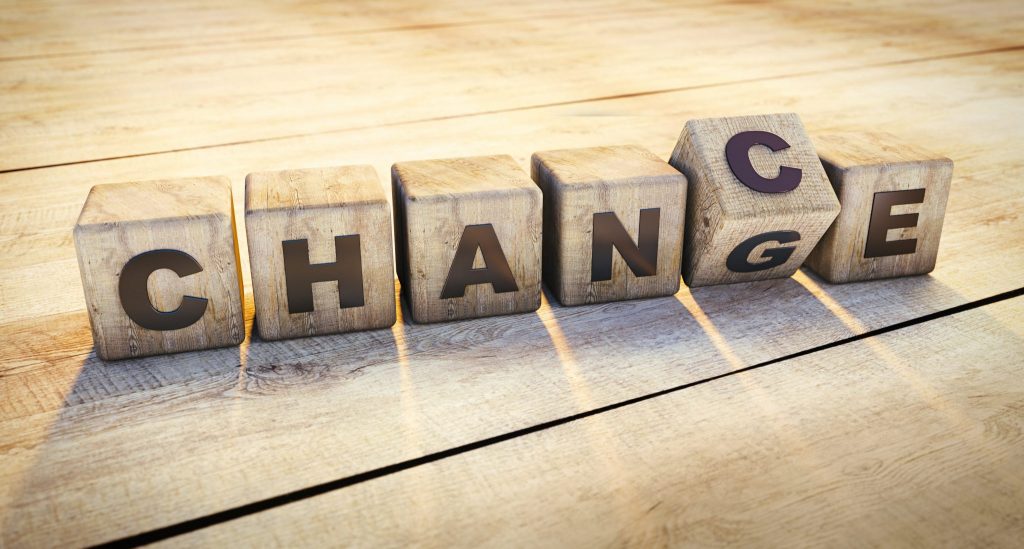Ch-ch-ch-ch-Changes [1]
David Bowie’s song “Changes” has a celebrated stutter, Ch-ch-ch-ch-changes while he wonders “I still don’t know what I was waiting for…” The song strikes a personal chord for many listeners because in the period of time it takes to utter those halting four syllables (ch-ch-ch-ch), individuals and organizations will react with shock then paralysis or cautious exhilaration the instant they learn that there will be a change.
Change management is big business. Individuals, teams, and multinational organizations invest time and money in experts to help them master the change curve, reduce resistance, and leverage the promise of revitalizing transformation. The cost savings measured in productivity and morale is well worth the investment of time and resources.
The human reaction to change is generally predictable. It falls along a curve that shows how performance and emotions are likely to be affected, from the rumors, to the announcement, through implementation, and to acceptance. Psychiatrist Elisabeth Kubler-Ross developed the curve based on her clinical work in grief and bereavement [2]. Subsequent research has shown that the curve applies equally to changes in business.
Pace: Some people zip quickly along the change curve and enjoy it. Others will hold on more tightly as they move through the process – if at all – and progress and regress along the way. In teams, individuals can motivate one another with confidence and joy, or infect one another with doubt and despair.
 By observing employees closely and talking with them, you can identify where they are along the change curve. By mindfully appraising your own behavior and emotions, you will be better able to help yourself and your organization expect the highs and lows and move through them together with compassion and drive.
By observing employees closely and talking with them, you can identify where they are along the change curve. By mindfully appraising your own behavior and emotions, you will be better able to help yourself and your organization expect the highs and lows and move through them together with compassion and drive.
The Status Quo: The power of the status quo[3] reinforces the desire for things to remain normal or the same. Every day, your mental and emotional energies are devoted to defending the belief that things are as they should be. Comfort with the familiar and the self-perpetuating nature of habits feed into change anxiety.
It is hard for people to imagine themselves in new situations[4], in new roles. Who they will be? How they will be perceived? On a primitive level, we fear that change threatens our survival and our identity. We don’t know whether a new system will be fair, whether we will survive, both literally and figuratively (what if I get demoted, fired, don’t get that promotion? What if the new boss doesn’t like me? What if they cut funding for my project?)
Successful change requires both social and neurological transformations. When we form habits our brains grow neural pathways that with reinforcement and practice fire preferentially over others. Well-developed routines and habits drive our behaviors and thoughts even before we consciously form intentions to act or not to act. Our habits provide us with context and make new challenges feel familiar.

Our habits reinforce assumptions and beliefs about the way the world is. We feel like we are in control of our lives and our work. We know what to do, and can to predict and handle what’s next. Our habits help us to feel safer in a chaotic world and freer from possible threats to our existence.
“Turn and face the strain”: In the workplace, decisions to change are usually authorized at the top and are imposed on employees whose only real choice is to adapt. Some will and some won’t. When change of personnel or direction is necessary, introducing the decision with consistency, pace, and appreciation for its impact will accelerate progress. Even when change is agreed to through collaborative teamwork, it will take time for people to readapt to their external environment and reconfigure their internal thoughts, feelings, and beliefs about the new order of things. Trust has to be re-established, new predictions validated, and confidence restored. It is possible to intentionally reframe how we think about change and in doing so, reprogram our brains, and create new routines and habits. This takes time, strategy, and open acknowledgement of the process.
A good leader will develop a system to help employees accept and articulate their concerns and to separate illusions and fears from the shared goals and challenges. A good change manager will help individuals and organizations process the vision, grasp the excitement and benefits of change, and develop the trust and confidence to let go of the past.
[1] http://www.azlyrics.com/lyrics/davidbowie/changes.html
[2] Kübler-Ross, E. (1969) On Death and Dying, Routledge, ISBN 0-415-04015-9
[3] Aaron C. Kay, Danielle Gaucher, Jennifer M. Peach, Kristin Laurin, Justin Friesen, Mark P. Zanna, and Steven J. Spencer, Inequality, Discrimination, and the Power of the Status Quo: Direct Evidence for a Motivation to See the Way Things Are as the Way They Should Be , Journal of Personality and Social Psychology © 2009 American Psychological Association 2009, Vol. 97, No. 3, 421–434 0022-3514/09/$12.00 DOI: 10.1037/a0015997
[4] Kegan, Robert; Lahey, Lisa Laskow (2009). Immunity to change: how to overcome it and unlock potential in yourself and your organization. Boston: Harvard Business Press. ISBN 078796378X


